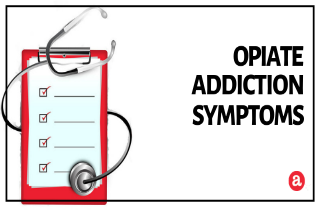The first step toward treatment of opiate addiction is recognizing its signs and symptoms. Treatment for opiate addiction begins with a clinical diagnosis, which is usually performed by a qualified health professional. Learn more about the signs and symptoms of an opiate addiction here and take the first steps toward recovery. Then, ask your questions about opiate addiction, the safety of rapid opiate detox, or being addicted to a narcotic at the end.
Opiate addiction signs
If you suspect someone that you love is suffering from an opiate addiction, it’s important to recognize the signs. Some common signs of an opiate addiction include the presence of the drug itself or opiate paraphanalia, which can include pill bottles, syringes, and bent and burnt spoons. A person suffering from an opiate addiction may also have physical signs, such as needle marks, or behavioral signs, such as mood swings. It’s not uncommon for opiate addicts to go from being agitated or depressed when they don’t have the drug in their system, for instance, to being euphoric or calm once they take it.
Symptoms of opiate addiction
Physical symptoms of opiate addiction – There are a number of other signs and symptoms of opiate addiction as well, many of which are physical symptoms. Physical signs and symptoms of opiate addiction include:
- constricted pupils
- fatigue
- impaired coordination
- slowed breathing
- slowed heart rate
- slowed reflexes
Diagnosis of opiate addiction
The fifth edition of the Diagnostic and Statistical Manual of Mental Disorders (DSM-V) is typically used to make a clinical diagnosis of opiate addiction. According to the DSM-V, there are seven criteria that may indicate an opiate addiction. In order to be diagnosed with a true opiate addiction, a person must meet three or more of these criteria, which include the following:
1. Continued opiate use despite harm. Although a person knows that opiates are harming health or relationships, s/he still continues to abuse them.
2. Excessive time spent in connection with opiates. A person may spend a good deal of his time using, trying to obtain, or recovering from the effects of opiates.
3. Opiates take precedence. A person may ignore other activities or obligations in order to use opiates.
4.Tolerance of opiates. Over time a person begins to need more of the drug to produce the same euphoric effects.
5. Unsuccessful attempts to quit. Attempts to quit taking the drug or slow down the drug’s use are not successful.
6. Using opiates more than intended. A person may use the drug for a longer period of time or in larger quantities than was originally intended.
7. Withdrawal symptoms. Physical and psychological withdrawal symptoms are often present when a person does not get the drug for a certain period of time. These withdrawal symptoms are typically alleviated when the person takes the drug again.
Opiate addiction symptoms: Can they be treated?
Yes. Opiate addiction symptoms can be treated, but it’s a long and difficult journey. The first step toward opiate addiction treatment is for the opiate addict to recognize that they have a problem. If an addict is unwilling to see the problem, an intervention may be in order. During an intervention, an addicts’ loved ones gather together and confront him/her in a non-threatening manner. This may involve telling the addict how opiate use affects them, and letting the addict know that they are afraid. An intervention is also an excellent time to inform an addict of the different options for opiate addiction treatment.
Then, there are two main types of treatment for opiate addiction symptoms – inpatient treatment and outpatient treatment. During opiate addiction treatment, medications like methadone may be used to alleviate withdrawal symptoms and speed up the detoxification process. Psychological treatment is also usually necessary, since it can help addicts better understand their addictions and how to break them. Behavioral therapy, group therapy, individual counseling, and family counseling sessions are standard during opiate addiction treatment.
Inpatient treatment – Inpatient opiate addiction treatment involves the addict staying in a hospital or rehabilitation center overnight or for several nights in a row. This type of treatment is often best during the detoxification stage and for individuals with severe addictions.
Outpatient treatment – Outpatient opiate addiction treatment is also available, and this type of treatment does not require any overnight stays. Instead, opiates addicts must attend therapy and addiction counseling appointments, usually with addiction counselors, psychologists, or psychiatrists.
Signs of opiate addiction questions
An opiate addiction diagnosis can only be made by a qualified medical professional. However, if you have any questions or wish to share your own experience, feel free to leave a comment below. We’ll do our best to help you and answer any questions or problems you may have.









Related Posts